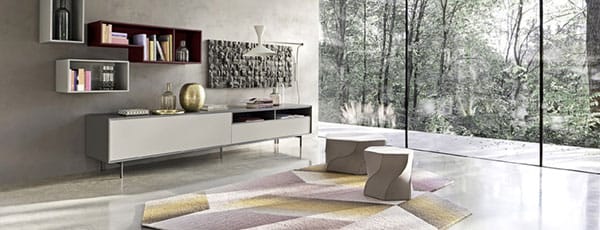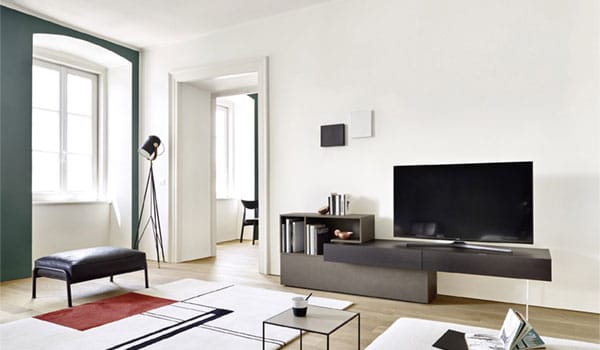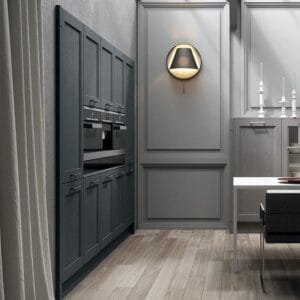Creating a bright, welcoming environment without natural light has always been a design challenge. From making rooms feel small to hiding key points, low amounts of natural light can have a large impact on the look and feel of a room; however, creating a bright and welcoming environment is far from impossible, and in this post, we’ll explain how to lighten a dark room with no natural light.
Often, the easiest way to brighten a room is via windows, however, there are many techniques you can use to make a darker space feel open, airy and well-lit. This comes from solid design choices, such as clever colour choices/combinations and using artificial lighting.
Layered Lighting
Without natural light, lighting fixtures become the main tool in your arsenal for brightening a dark room. Many tricks can be employed, but the key is to mix different types of lighting to create a layered and balanced effect—often referred to as layered lighting.
Layered lighting when lightening a dark room should fall into three types:
- Ambient Lighting – This is the room’s primary source of light, and should be the most prominent. Ceiling lights, chandeliers and recessed lighting all serve as fantastic ambient lighting choices. For dark rooms, it is best to choose fixtures which diffuse and spread the light across the room evenly, whilst being bright enough to fill every corner.
- Task Lighting – For specific activities such as reading, working or cooking, task lighting focuses light on particular areas. Great examples of this are desk lamps, under-cabinet lighting or floor lamps. When working with low-natural-lighting rooms, task lighting is a must; this is because it will be the primary source of direct light when participating in activities within the room.
- Accent Lighting – This lighting allows you to explore your creativity and add depth to a room; accent lighting includes wall sconces, picture lights, and the ever-famed LED strips which can help draw attention to specific parts of the room. By using accent lighting in rooms with no natural light, you can draw attention away from the darker parts of the room, creating focal points which distract from the darker parts of the room.
Optimising Your Colour Pallet
The colours you pick for your low-light room have a significant impact on how bright and open it feels. Darker colours will always make a room feel smaller, whereas brighter colours and the usage of whites will always make a room feel more open and larger by comparison.
Our advice in this area centres around the following:
- Stick with light colour pallets – Lighter colours naturally reflect more light, which is why they make the room feel larger (much like the usage of mirrors). Whites, soft greys and creams create the perfect pallets for making your low-light room feel much larger.
- Use Mirrors Strategically – We have covered this in our blog post about the benefits of using mirrors in interior design, the strategic use of mirrors can help reflect light around a room, which complements a lighter colour pallet to create a space which visually feels much more open.
Choosing The Right Furnishings
When decorating a room with no natural light, it is essential to consider how your furnishing interacts with your lighting and space. This is important, as your furniture shouldn’t block light or conflict with the lighter pallet used to generate space.
- Light Coloured Furniture – Furniture which is light in colour, or uses neutral tones/finished helps to reflect the light instead of adoring it. As such, avoid overly dark furniture which can make a room feel closed off.
- Avoid Bulky Furniture – Furniture which has solid side panels, or has high height (when not against a wall etc) should be avoided, as these types of furniture have a tendency to block light, casting shadows. This reduces the amount of light which can be reflected around the room by increasing shadows.
Using Greenery
The usage of plants in the home has become a staple in contemporary design, as these additions generate several positive effects and emotions. From adding vibrancy and vitality to a room to boosting productivity, the usage of greenery has no limits. When used in a room with low natural light, the greenery provides a contrast against lighter colours and helps soften the space, creating a more inviting feel. Owing to the low natural light, we would suggest using artificial plants, as these will still add texture and contrast to the room.
Conclusion
Whilst it may seem challenging to design a room with no natural light, there are ways and means of achieving the desired outcome by honing in on both simple and intermediate interior design techniques. By focusing heavily on layered lighting, lighter colour pallets and choosing the right furniture, you can create a space which feels open, inviting airy and comfortable. The key is to make the most of the artificial light available, whilst allowing the room to do the bulk of the work, allowing you to overcome the absence of natural sunlight.











